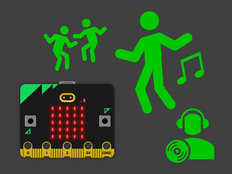第 1 步:制作
它是什么?
使用新版micro:bit的麦克风传感器检测你周围的声音响度,并通过简单的柱状图显示。
介绍
编程指南
学习目标
- 如何使用新版micro:bit的内置麦克风输入传感器测量你周围环境的声音响度
- 如何在LED显示屏输出上用图形来表示输入传感器的数据
工作原理
- 新版micro:bit的麦克风将检测到的声响程度用数字0至255来表示。 0表示最安静,255是它可以进行的最响的声音测量。
- 程序使用foreever循环来持续检测麦克风输入的声响,并在LED显示屏上绘制柱状图来表示声响值。
- 测得的声音越响,柱状图就越高。
所需材料
- 新版含音频设备的micro:bit(或者MakeCode模拟器)
- MakeCode或者Python编辑器
- 电池盒(选配)
第 2 步:编程
1from microbit import *
2
3# function to map any range of numbers to another range
4def map(value, fromMin, fromMax, toMin, toMax):
5 fromRange = fromMax - fromMin
6 toRange = toMax - toMin
7 valueScaled = float(value - fromMin) / float(fromRange)
8 return toMin + (valueScaled * toRange)
9
10# set of images for simple bar chart
11graph5 = Image("99999:"
12 "99999:"
13 "99999:"
14 "99999:"
15 "99999")
16
17graph4 = Image("00000:"
18 "99999:"
19 "99999:"
20 "99999:"
21 "99999")
22
23graph3 = Image("00000:"
24 "00000:"
25 "99999:"
26 "99999:"
27 "99999")
28
29graph2 = Image("00000:"
30 "00000:"
31 "00000:"
32 "99999:"
33 "99999")
34
35graph1 = Image("00000:"
36 "00000:"
37 "00000:"
38 "00000:"
39 "99999")
40
41graph0 = Image("00000:"
42 "00000:"
43 "00000:"
44 "00000:"
45 "00000")
46
47allGraphs = [graph0, graph1, graph2, graph3, graph4, graph5]
48
49# ignore first sound level reading
50soundLevel = microphone.sound_level()
51sleep(200)
52
53while True:
54 # map sound levels from range 0-255 to range 0-5 for choosing graph image
55 soundLevel = int(map(microphone.sound_level(), 0, 255, 0, 5))
56 display.show(allGraphs[soundLevel])
57 第 3 步:完善
- 创建你自己的方式来显示声音响度,例如根据不同的声响来显示不同的表情符号
- 制作一个虚拟噪音警报器,仅当声音超过某个级别时闪烁——可以使用它来帮助你的课堂保持安静
This content is published under a Creative Commons Attribution-ShareAlike 4.0 International (CC BY-SA 4.0) licence.


